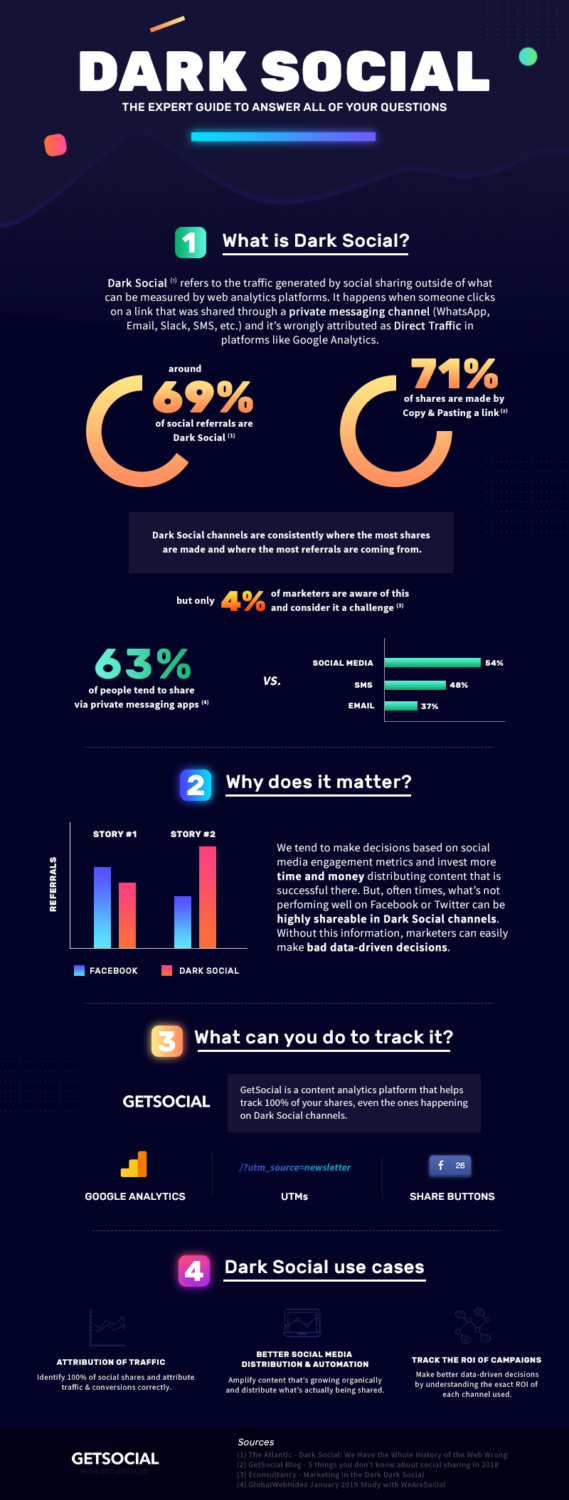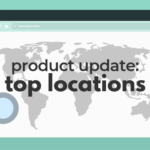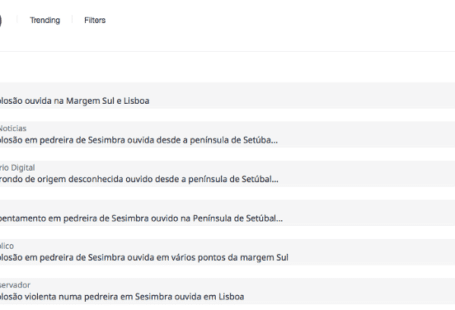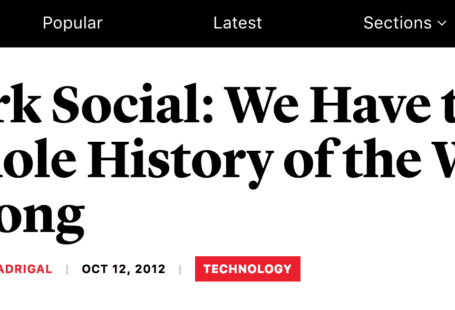Although the concept of Dark Social has been around for a while, many don’t recognize it as a challenge in measuring audience engagement accurately.
Our digital world is constantly changing. Trends come and go. Yet one thing remains true throughout time: your audience is at the center of everything you do.
Metrics such as Reach and Impressions have lost their appeal when measuring content performance, and marketers have been looking at engagement metrics like clicks, shares, comments and mentions.
But in a survey with 1,000 European marketers conducted by Econsultancy, only 4% of the respondents see Dark Social as a challenge in building a joined-up customer journey. The study suggests that the majority of marketers are unaware this concept even exists.
Whether people know it or not, Dark Social continues to be a tricky obstacle for businesses, affecting content marketing, social media strategies and even sales.
So let’s walk through everything you need to know.
1.1 Dark Social findings over the years
1.2 Common misconceptions about Dark Social
2. Why is Dark Social Important?
3.1 GetSocial
3.1.1 Dark Social Calculator
3.2 Google Analytics
3.3 UTMs (and their problems)
Back in 2012, Alexis C. Madrigal figured out that the referral data we see from Facebook and Twitter on web analytics platforms is only the tip of the iceberg when it comes to social traffic. Even 7 years ago, before apps like WhatsApp had the relevance they have now, most users were sharing via private messaging channels.
This resulted in significant amounts of traffic being wrongly classified as Direct Traffic, implying that users landed on certain pages of a website by typing the full URL or clicking on a bookmark.
While that sounds plausible for a simple link like https://getsocial.io, it’s unlikely that someone who has never been to our site before just randomly typed https://getsocial.io/resources/uncovering-dark-social onto their browser to see our whitepaper.
If it’s not Direct Traffic, what’s a more fitting term for this data?
Thanks to Alexis Madrigal, we now call it Dark Social.
Dark Social refers to the traffic generated by social sharing outside of what can be measured by web analytics platforms. It happens when someone clicks on a link that was shared through a private messaging channel, such as WhatsApp, Slack, Email, SMS, etc. It’s wrongly attributed as Direct Traffic in platforms like Google Analytics but it’s much more than that.
This misattribution happens because social sharing in private messaging channels returns no referrer data, hence the direct attribution. And while you, the marketer, consider the traffic to be social (Facebook Messenger, as an example), the tech side of things is a little bit more frustrating, by not discerning that source as anything different to a direct hit. Because of this, this traffic data does not typically fit into its Social source, which looks at traffic coming from public shares made on Facebook, Twitter, etc.
But the fact is, in the research that Alexis conducted, he saw that private channels are almost always the top referral sources.
1.1 Dark Social findings over the years
- 2012 – as much as 69% of social referrals were Dark Social, according to Alexis’ research alongside Chartbeat
2018
- In a content trends report we did with Buzzsumo, we found that Dark Social sharing was at 65%, still overthrowing all public sharing
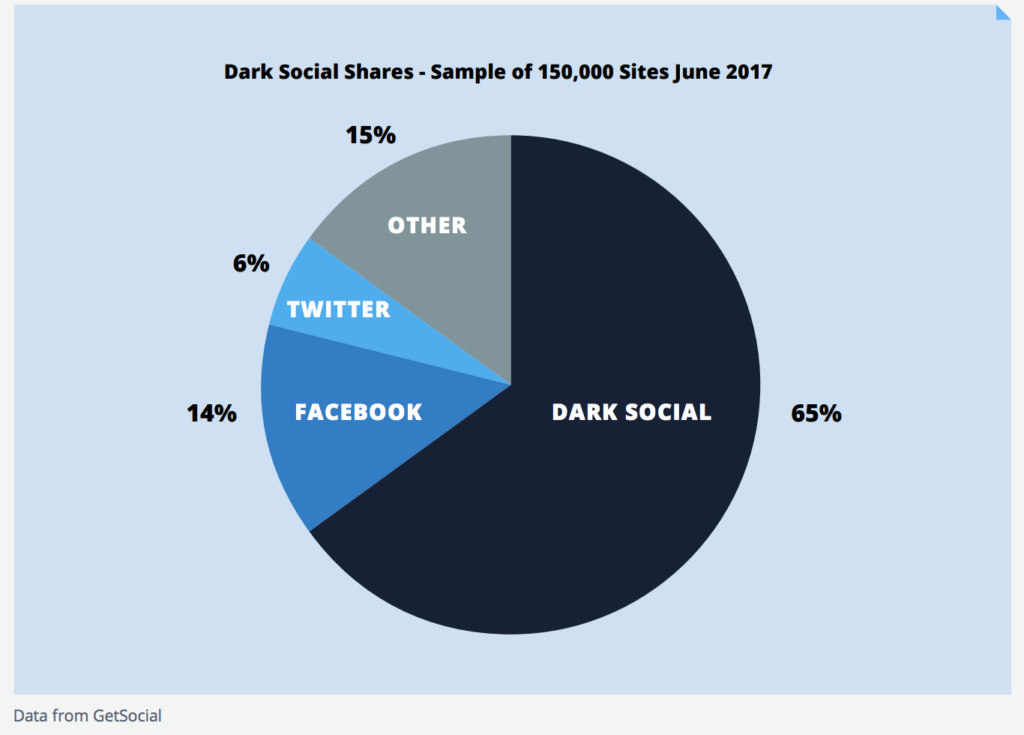
- Through our research for our whitepaper, we saw that, on average, 10% of the traffic to the website comes from shares on private channels, which is a big percentage for websites with large amounts of traffic
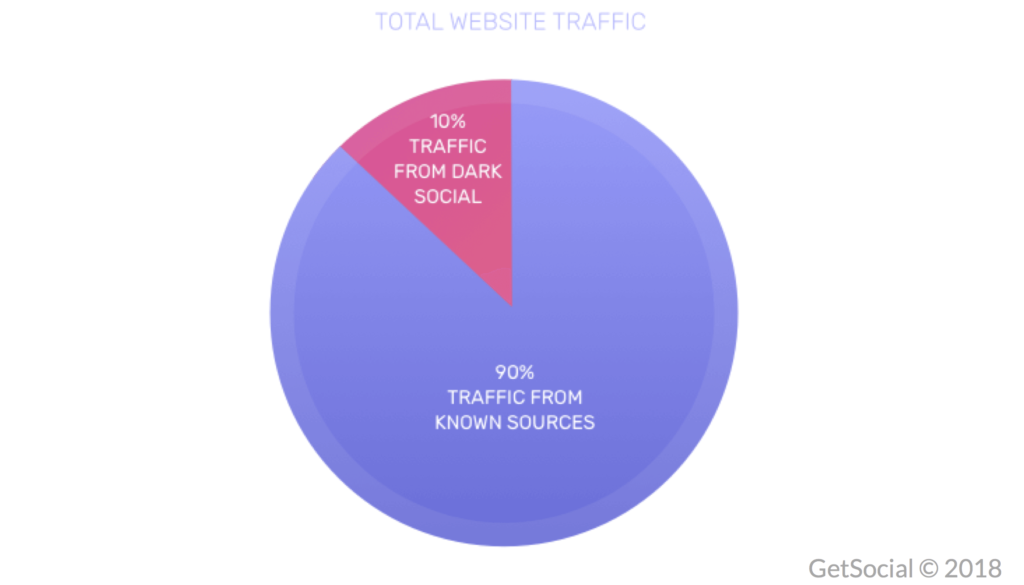
- Only 29% of shares are made through share buttons vs. 71% of shares made through Copying & Pasting a link on a browser or a private channel
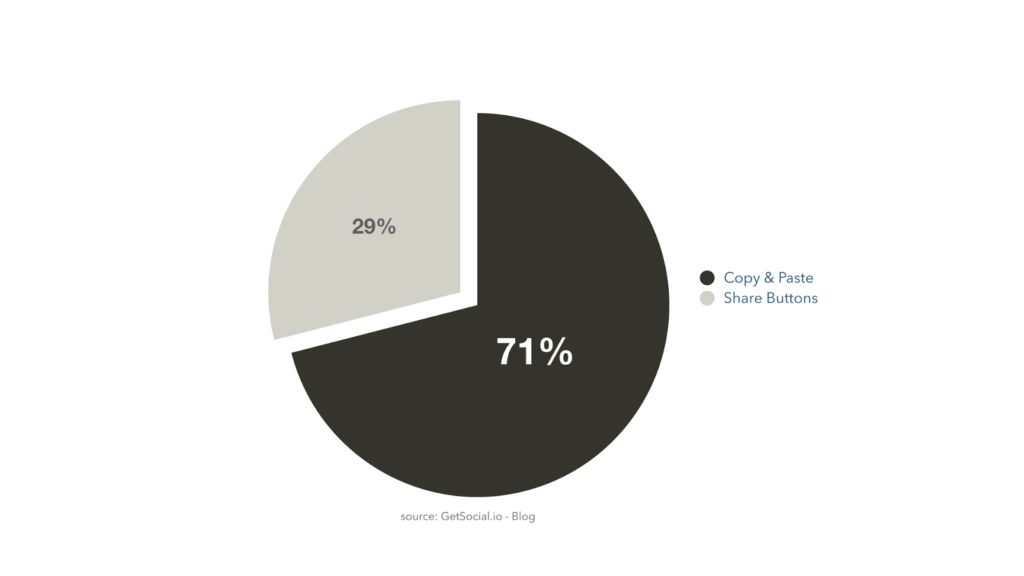
- 2019 – in a study led by We Are Social, it was found that 63% of people prefer to share content on dark social channels
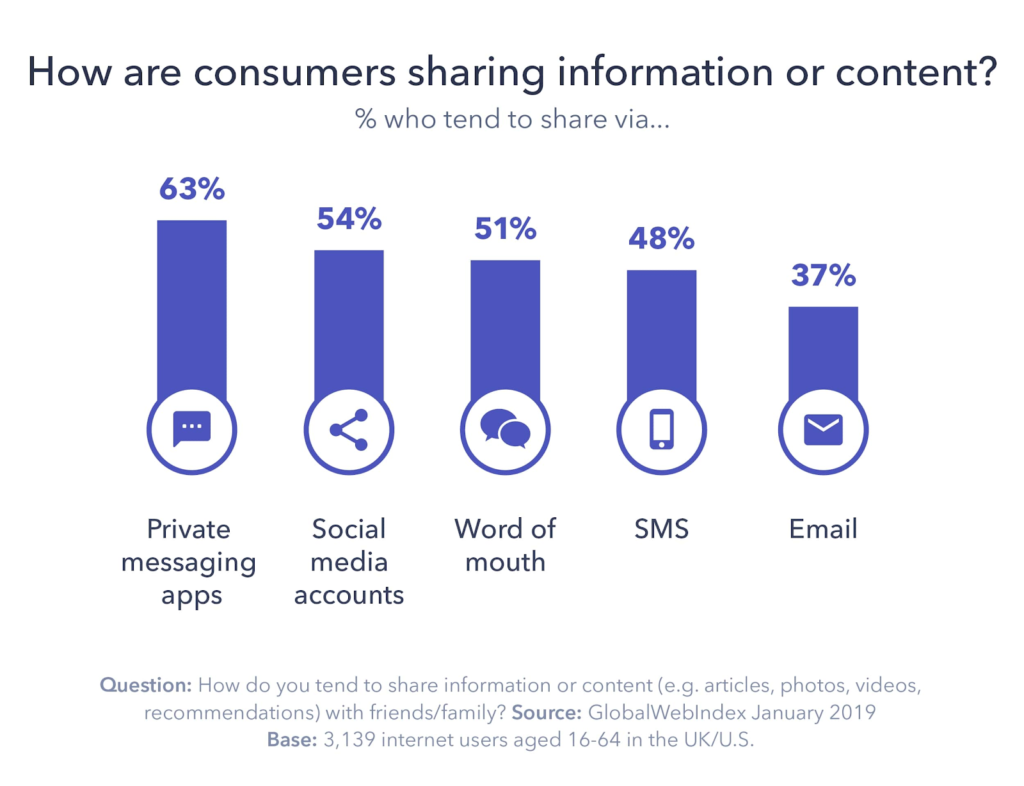
1.2 Common misconceptions about Dark Social
Over the years, the concept of Dark Social has grown massively in popularity and, although up to 94% of marketers still don’t know what it is (Econsultancy study mentioned above), you can find a lot of information on the topic if you simply search for the term.
However, with a lot of buzz comes a lot of confusion.
Aside from those who assume that Dark Social has anything to do with the dark web (spoiler: it doesn’t!), other misconceptions have surfaced and marketers may still be confused about its true meaning.
We actually covered this a while ago in a blog post where we identified and debunked 4 myths commonly associated with Dark Social, but here’s the short version:
- Dark Social is NOT customer support. People will often claim that brands like Starbucks and Adidas are tackling Dark Social by sharing content and engaging with their users through private channels, such as WhatsApp. Although this is great customer support and community building, it doesn’t constitute as Dark Social.
- Number of shares is NOT the same as traffic generated from shares. Not necessarily, at least. Your most popular article may have 500 shares, but when it comes to the additional traffic that those shares actually generated, they can be lower than 500, the same or much higher. You may even have just 1 share and yet thousands of sessions generated from it.
- Dark Social does not always equal Private Channels. WhatsApp is an example of a private channel that generates dark traffic and dark social shares. However, creating a WhatsApp group to speak to customers doesn’t relate to Dark Social if there’s no traffic to the website coming from these groups.
- UTMs are great, but they’re not a perfect solution. More on this below.
Read our full post on the 4 myths of Dark Social to get better examples of this.
Given its name, Dark Social can often scare people away with the assumption that it’s something bad that needs to be avoided.
In reality, other than the fact that this data may be hard to track, it’s really not that bad. Moreover, it’s practically impossible to stop it from occurring — given recent news, such as Facebook’s shift to private, it’s easy to predict that private sharing will only continue to rise in the years to come.
Why is this important?
As business owners, marketers, audience development teams, social media teams, our eyes are always set on the customer and how we can improve our strategies to meet their needs and, consequently, increase our ROI.
How can you make the best data-driven marketing decisions when you don’t have access to all the data?
Unlocking the power of Dark Social is not lightyears away — it’s a key step you can take now to better understand your audience and improve engagement, by providing content that your visitors will actually read, share and buy.
When was the last time you looked at your Direct Traffic to make a decision regarding your content? There’s a much bigger chance that you’re looking at your Social Traffic, right?
Let’s look at the following example…
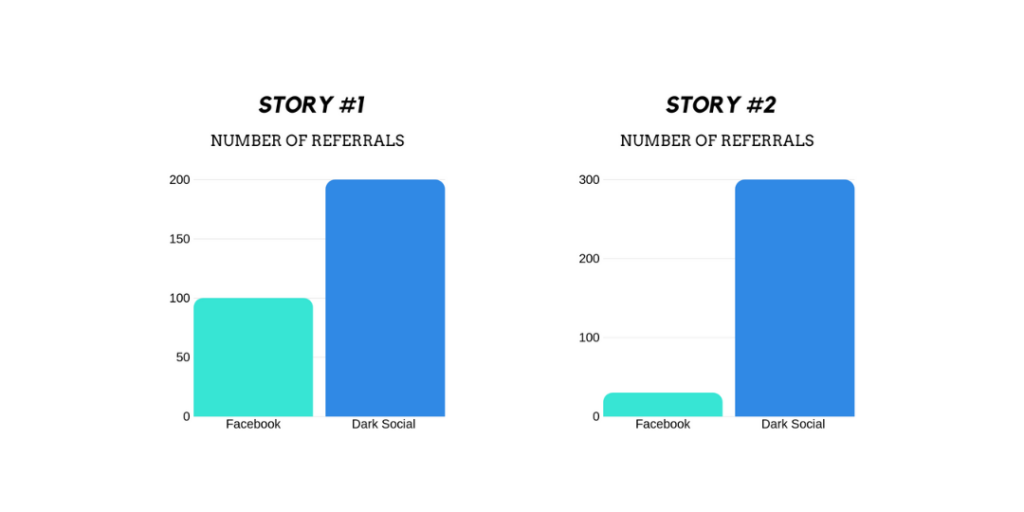
Can you guess which story is more successful?
It’d be fairly easy to open Google Analytics and see the Facebook referrals for these two stories on our Social Traffic. We would assume that Story #1 was driving better results, thus invest more time and money distributing it, expecting it will continue to be successful.
Publishers are one of the businesses that can be most negatively impacted by the increase of private sharing when it’s not properly tracked. That’s because their profit depends on their articles’ effectiveness to bring traffic to the website and increase ad revenue, premium subscriptions, etc.
By not tracking Dark Social they are completely oblivious to the fact that, though Story #2 had a poor performance on Facebook, it’s actually being more shared in private channels and, most likely, driving more traffic from there. Without this information, this story would probably go unnoticed.
This is where Dark Social stops being a scary thing and becomes an important source of information for better decision making, useful to anyone that has a significant content strategy and cares to analyze their data.
In his study with Chartbeat, Alexis Madrigal saw that, in just one day, around 56% of all social traffic going to The Atlantic was coming from Dark Social channels, beating Facebook with just 21%.
We’ve seen firsthand throughout the years that this is standard for most of our customers.
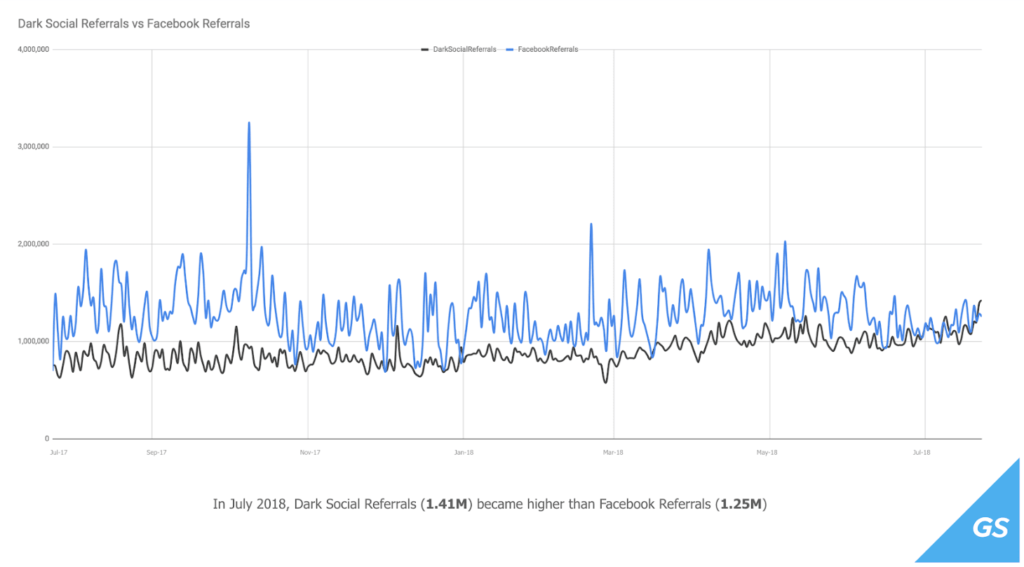
Dark Social channels are consistently where the most shares are made and where the most referrals are coming from.
If you’re ignoring that, you could be missing a huge chunk of data that could make a difference in your distribution and content production strategies.
3. Can you track Dark Social?
By now I’m sure you’re thinking “This is great and all, but isn’t it impossible to track dark social?”.
It’s not that impossible, though you may come across a lot of articles on the subject that will tell you otherwise. There’s a way you can start tracking this data, or at least a few alternatives to get a general sense of it.
3.1 GetSocial
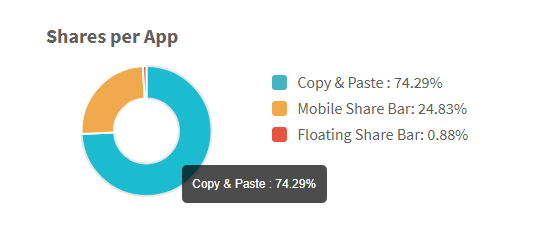
GetSocial is a content analytics platform that helps you understand how your audience is sharing content, giving you the tools to make the most of this data. Our solution allows you to see, for each of your pages and content, where it’s being shared and where the most referral traffic is coming from, even if it’s coming from Dark Social channels.
You can read more about it on our website.
Feel free to request a demo with us and we’ll be happy to explain how you can use GetSocial to meet your goals.
3.1.1 Dark Social Calculator
Beyond our analytics platform, we’ve also developed a free Dark Social calculator that you can use for a quick estimate of how much dark social traffic could be going to your website.
Simply put in your email to connect to your Google Analytics!
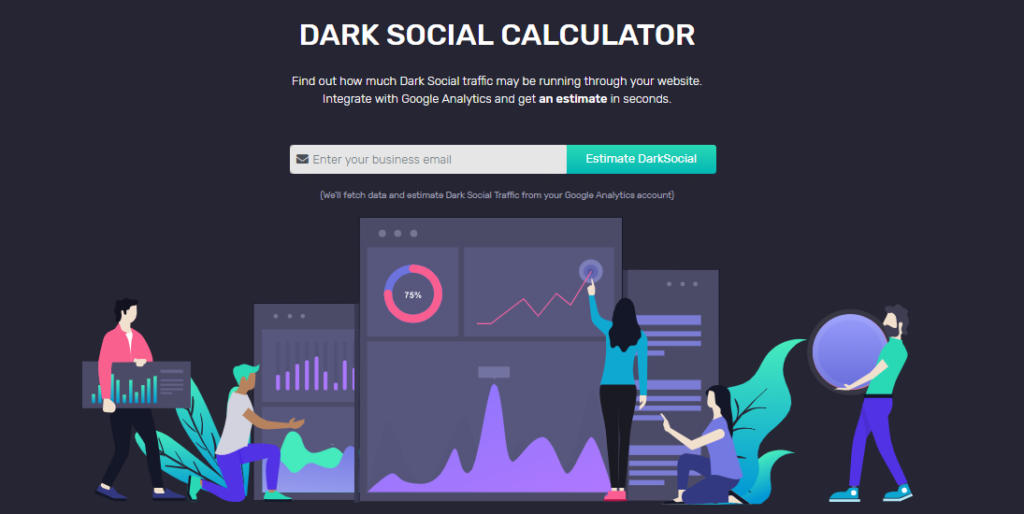
3.2 Google Analytics
Through Google Analytics, you can get a good enough understanding of Dark Social if you don’t have a need for a more accurate view of your content’s results.
You can achieve this by creating an advanced segment.
With advanced segments, Google Analytics allows you to filter your traffic according to your criteria. In the case of tracking dark social, you will want to separate the overall visitors from (1) those who came to your website through direct traffic and (2) those who didn’t go through the homepage.
Here are all the steps:
- Go to Audience → Overview → + Add Segment

- Create a new segment by clicking on ‘+ New Segment’
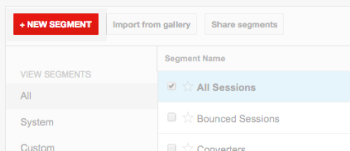
- Name your segment ‘Dark Social Traffic’ (or whatever else you find fitting). On the menu, go to Advanced → Conditions. Here you will create two conditions, exactly as shown in the screenshot below. These are the conditions (1) and (2) mentioned previously.
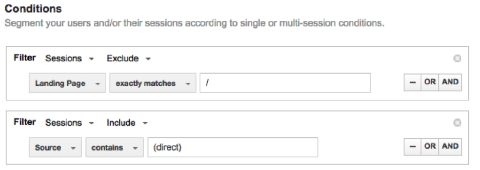
- Click the blue ‘Save’ button next to the title and you’re all done.
3.3 UTMs
UTM parameters are the most common way to attribute traffic sources and they’re used by most marketers. Google even has a pretty useful tool to quickly build your link.
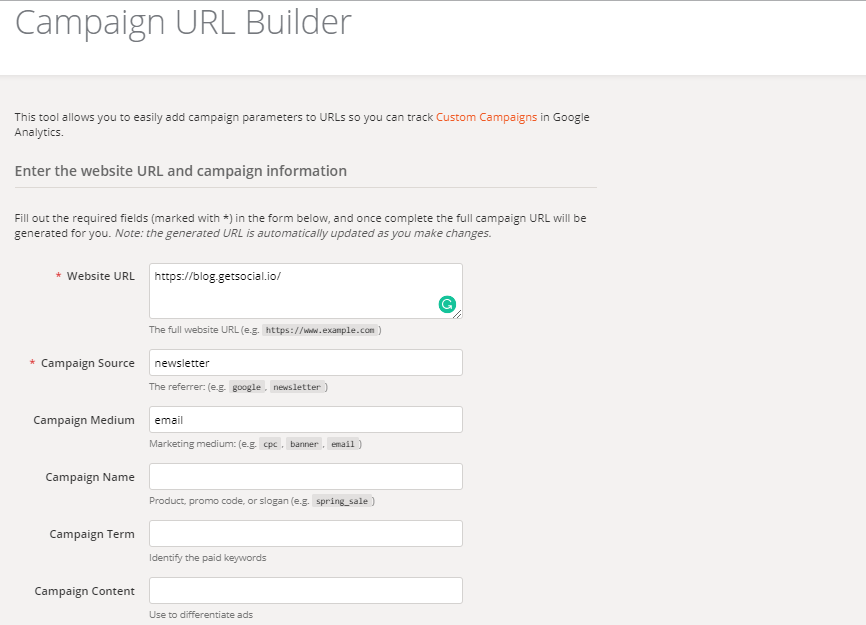
By adding just a few parameters to your URL, you can, for example, share a link in your email newsletter and all incoming traffic from that link will automatically be specified in your analytics.
At first glance, this seems like a foolproof way of solving the mystery of Dark Social, right? That’s because most people assume that a user’s interactions with a link stop after the first click.
But social sharing makes attribution a lot more complicated.
Following the example above — imagine someone opens our newsletter and clicks on our CTA to visit our blog. The URL they are led to would look something like this:
https://blog.getsocial.io/?utm_source=newsletter&utm_medium=email
They then decide to copy this URL and paste it on Twitter to share with their followers.
Suddenly, we may have 100 people on Twitter clicking on that link and showing up on our Google Analytics as though they were coming from email. Not only that, we’re wrongly led to believe that 100 people opened our newsletter when, in fact, it may have been just 1 person.
This can go on for many more levels and have a massive impact on the way you view your campaign’s results and communicate them to your team. While it’s a good solution, keep in mind that is has its limitations.
We talk more about this in a post about what we call the fundamental flaw of UTM parameters.
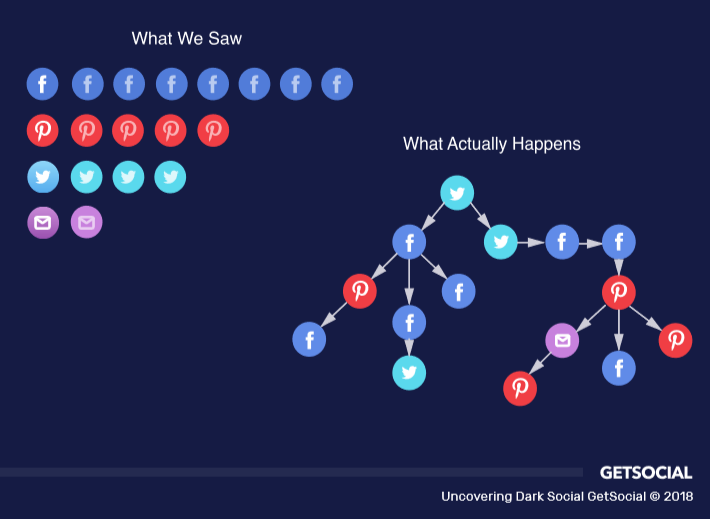
There are various ways you can use Dark Social to make better data-driven decisions. A few use cases we’ve already touched on throughout this post include:
- Accurate attribution of traffic sources
- Effective social media distribution
- Tracking the ROI of campaigns
Ultimately, having full visibility into which pages are being shared in private conversations allows you to identify trends and get an overview of the actions taken after these sharing patterns.
You can focus on amplifying content that’s growing organically and, more importantly, strive to identify what makes a page shareable so that you may apply it to your future content schedule.
Publishers and other content websites, as previously mentioned, can find extremely valuable insights in Dark Social data to guide them.
With our Social Media Automation tool, for example, we’re able to identify in real-time when content is becoming viral by being highly shared, and we automatically share it on the social networks that will drive the best results.
Moreover, E-commerce brands can just as easily benefit by identifying which product pages are being shared the most and tracking conversions that happen as a result.
Final notes
At the end of the day, the importance you give to Dark Social and how you use it depends on your goals.
A lot of businesses mistakenly assume they already know their audience well enough, but hopefully now it’s clear that Dark Social should not be overlooked. It’s just as important as any other social data to guide your marketing strategy.
Keep in mind that customers are at the center of everything and this is not an obstacle to reach them, but rather an opportunity to understand their behaviors and needs better than before.
Let us know how you feel about the impact that Dark Social has on your web traffic!
Dark Social Infographic
Share this infographic!
For more information, download our free whitepaper here:
Interested in knowing more about Dark Social & Analytics?
[su_button url="https://getsocial.io" target="_blank" style="flat" background="#21D2B5" color="#ffffff" size="7" wide="no" center="yes" radius="auto" icon="" icon_color="#FFFFFF" text_shadow="none" desc="" onclick="" rel="" title="" id="" class=""]SIGN UP FOR FREE[/su_button]

